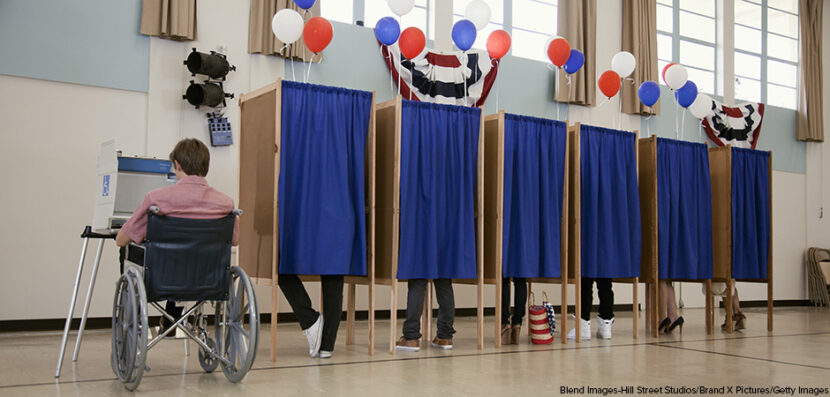Voting with Disabilities
Usually when we talk about voter access, we think about things like the number of polling places available or whether voter ID is required. But for the estimated one in six voters who have a disability, the voting process can be more complicated (and often more difficult). Luckily, in the 2020 presidential election, fewer people with disabilities reported experiencing voting challenges. Why is that, and what can we do to close the gap for voters with disabilities even further? Here, Election Central takes a closer look.
What Are the Challenges?
What are some of the challenges that people with disabilities face when they attempt to cast their ballots? Some individuals have vision challenges or cognitive impairments that make reading the ballot or figuring out how to use the voting equipment difficult or impossible. Mobility and transportation challenges can prevent a voter from getting to the polls in the first place.
Once they arrive, physical barriers (such as lack of ramps, or doorways that are too narrow for a wheelchair or walker) can also limit a person’s access. In fact, as of 2017, roughly two-thirds of polling places examined by the federal government had at least one of these physical barriers in place.
A voter who has trouble standing for long periods of time may face the challenges of long lines and wait times. Disabled voters of color experienced a wait time of about 45 minutes at the polls in 2020. Compare that to the average 19-minute wait time for white non-Hispanic voters with disabilities.
Closing the Gap
According to a report from the U.S. Election Assistance Commission, 26 percent of voters with disabilities reported trouble voting in 2012. But in 2020, that number dropped to just 11 percent. Why? A large part of the change has to do with the huge improvement in access to mail-in voting that we saw in the last election as a result of the COVID-19 pandemic. In fact, nearly 75 percent of voters with disabilities chose to vote by mail or through in-person early voting in 2020.
But what about those who chose to vote in person? Those numbers dropped as well: from 30 percent reporting problems in 2012, to just 18 percent in 2020. Much of this can be attributed to election workers, who were perceived by voters with disabilities as being more respectful and willing to help than in 2012.
More to be Done
Though the study shows that the voting experience has improved for people with disabilities, it’s still not okay that about one in nine disabled voters ran into trouble while voting–double the rate for voters without disabilities. And overall, voter turnout was 7 percent lower for voters with disabilities than for those without.
So, what can be done to further close the gap? Though are laws to protect voters with disabilities. It’s important to ensure poll workers know how to assist voters with disabilities and how to identify (and eliminate) possible hurdles.



